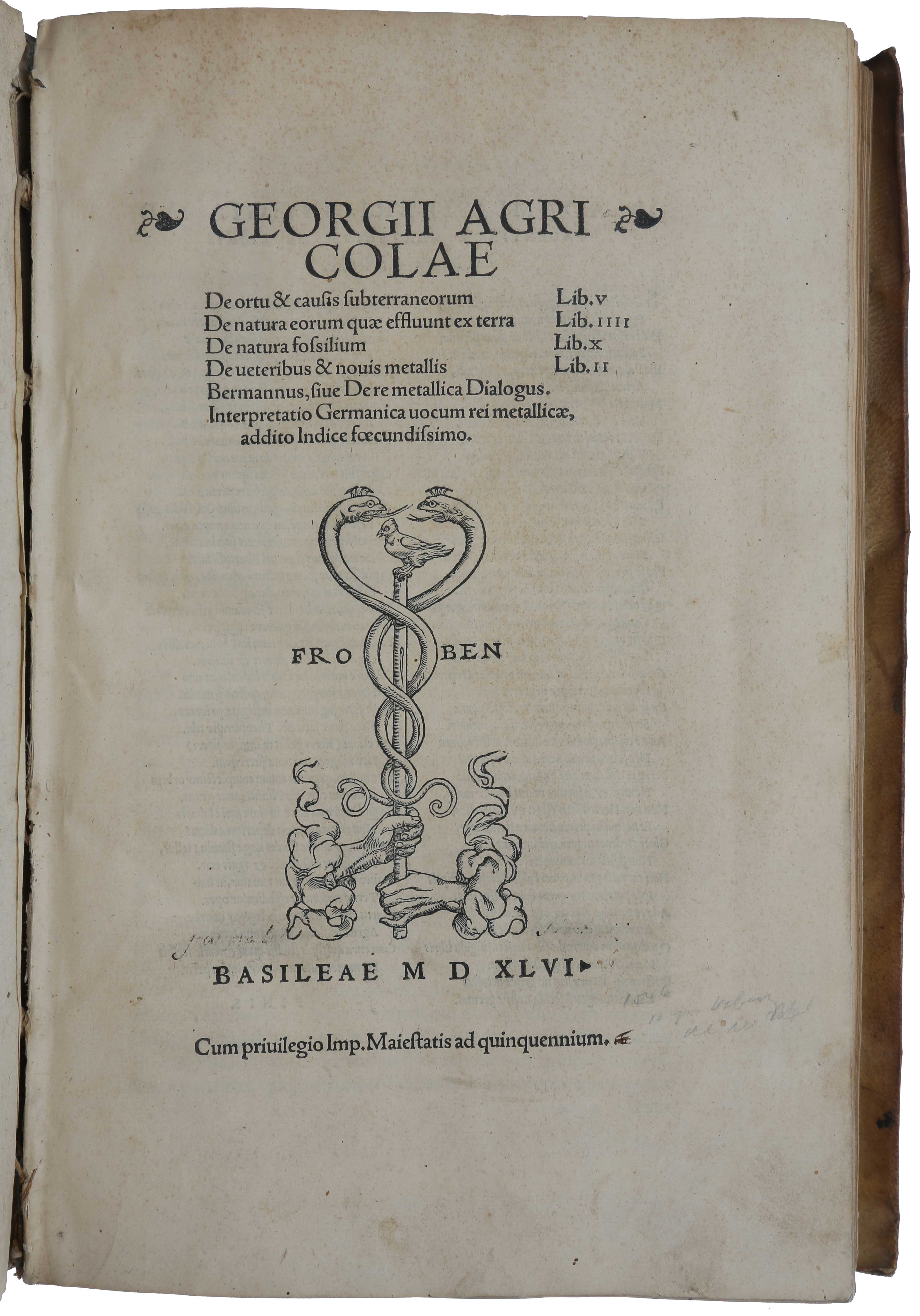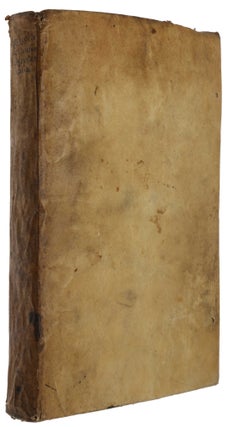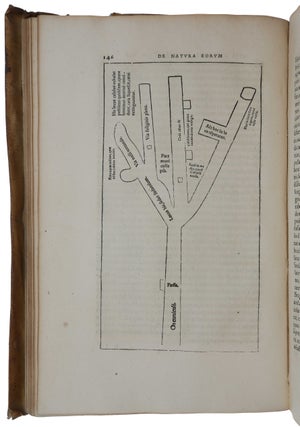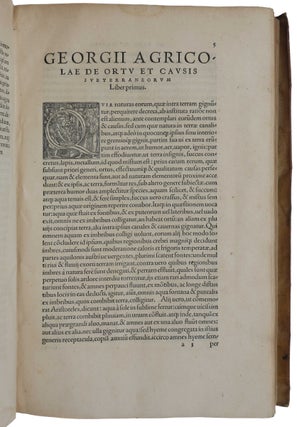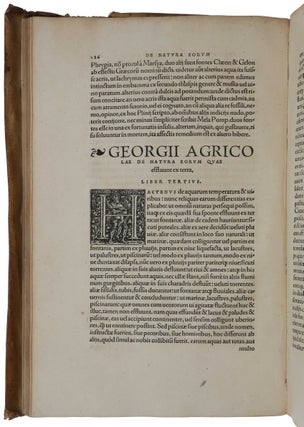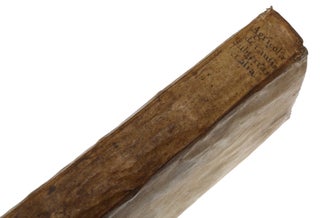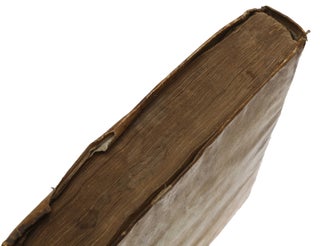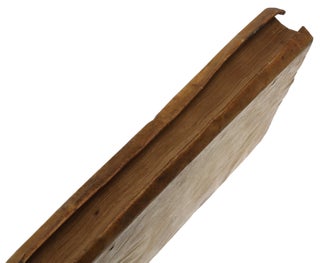De ortu & causis subterraneorum Lib. V. De natura eorum quae effluent ex terra Lib. IIII. De natura fossilium Lib. X. De veteribus & novis metallis Lib. II. Bermannus, sive de re metallica dialogus. Interpretatio Germanica vocum rei metallicae, addito Indice foecundissimo.
Basel: Hieronymus Froben, 1546.
An exceptionally fine copy, completely untouched in its original binding, of ‘the first handbook of modern systematic mineralogy’ (Grolier/Horblit 2a). “Georgius Agricola (latinized from the German ‘Georg Bauer’) became interested in the theoretical and practical aspects of mining, metallurgy and geology after being appointed town doctor of Joachimsthal, a silver-mining community on the east side of the Erzgebirge mountains in what is now Czechoslovakia. He published his first work on mining, Bermannns sive de re metallica dialogus, in 1530, and followed it sixteen years later with this collection of five treatises on geology and metallurgy, including the first work on physical geology (“De ortu & causis subterraneorum”); the first systematic mineralogy (“De natura fossilium”); a work on subterranean waters and gases (“De natura eorum quae effluunt ex terra”); a treatise on references to minerals and mining in classical history (“Dc veteribus et novis metallis”); and a reprint of Bermannnus. “De natura fossilium,” after De re metallica, must be considered Agricola’s most important work; in it he rejected the traditional arbitrary alphabetical listing of “fossils” (i.e., stony substances dug from the earth), and attempted to classify them according to their physical properties” (Norman).
In De Natura Fossilium, Agricola rejected many myths associated with gems, and the system of classification that is inferred from his writings exhibits a degree of generalization not found in earlier handbooks. His work represented a major advance over previous writings on rocks and minerals in that it classified them, not alphabetically or by their supposed mystical powers, but by simple physical properties. Minerals are grouped into (1) earths, like clay, ochre, etc., (2) stones like gems, semi–precious and unusual as distinguished from rocks, (3) congealed juices like salt, vitriol, alum, etc., (4) metals and (5) compounds, being homogenous mixtures of simple substances and forming minerals like pyrite, galena, etc. Agricola applied physical properties such as solubility, fusibility, odor, taste, color, etc. to distinguish between mineral varieties.
Although Agricola’s work included no pictures, his descriptions of fossils are often instantly recognizable: “Lapis judaicus … usually occurs in the form of symmetrical acorns. Prominent lines run from the blunt to the pointed end and these are so regular they appear to have been made in a lathe and resemble the striae on a shell. The people who call this mineral pyren liken these lines to the bones of a fish that extend from the back down to the belly … When split open it is light inside and glistens like marble and in some cases the outside also has a high luster.” Again: “Certain rocks, when split open, are found to contain shells; for example, the conchites beds of Megara and the rocks of France. . . Ostracites is a stone that takes its name from ostreum [oyster] which it resembles. There are two species, the larger found in the moat on the north side of Hildesheim … The smaller species is found not far from Hanover on a cliff near the village of Linda in an unctuous light green earth … It forms in strata that are conspicuous. When tapped with the finger it has the sound of a jug.” Agricola noted the resemblance of many of his “fossils” to living organisms, but rarely stated that any of his fossils actually did represent once-living organisms. The question of whether fossils did represent once-living organisms was still debated in Agricola's time, and was not finally resolved until the early 18th century.
Book I of De natura fossilium describes the characteristics of minerals such as color, brillance, taste, shape, hardness, etc. Book II describes the earths and Book III reviews the minerals made of congealed juices, and includes salt, soda, potash, saltpetre, alum, vitriol, orpiment, etc. Book IV treats camphor, bitumen, coal, amber, etc. Book V covers lodestone, bloodstone, gypsum, talc, asbestos, mica, geodes and various fossils, flourite and quartz. Book VI treats gems and other precious stones. Book VII in on rocks like marble, serpentine, onyx, alabaster, limestone, etc. Book VIII covers metals, while Book IX describes various furnace observations such as making brass, gilding, tinning and furnace products like slag, copper flowers, etc. Book X covers compounds that embrace the description of a number of recognizable silver, copper, lead, quicksilver, iron, tin, antimony and zinc minerals.
“Agricola's first work on mining and mineralogy is his Bermannus, 1530. It is in the form of a conversation in which Bermannus, a miner (really named after his friend Lorenz Bermann, d. 1533) and two Italian physicians, Nicolaus Ancon and Johannes Naevius, discuss mines and minerals. At the end is a small glossary of German mining terms with Latin equivalents by Petrus Plateanus (a schoolmaster at Zwickau), which was much enlarged in later works of Agricola, when it was called Interpretatio Germanica vocum rei metallicae and supplemented by a Nomenclatura Latina Graecaque Germanice reddita, attached to the De Natura Fossilium (see below), and a Nomenclatura secunda. The Bermannus gathered together much unsystematic and empirical knowledge of the miners. It was reprinted in 1546 with an enlarged list of synonyms and four new works [the offered collection] …
[The other three works in the collection are:]
“De ortu et causis subterraneorum libri V. This is mostly on geology. It gives an approach to the modern theory of ore deposits and rejects the old idea — still believed by Boyle – that rock crystal is formed from water by intense frost (satis intelligimus ex sola aqua non gigni lapidem ullum), mentions Hecla as an active volcano and explains the origin of minerals and certain rocks as due to a petrifying juice (succus lapidescens).
“De natura eorum qui effluent ex terra, libri IIII. This deals with water, mine gases, volcanic eruptions and exhalations.
“De veteribus et novis metallis libri II. This is the first history of metals, with accounts of mining, and containing anecdotes (not to be found elsewhere) respecting the ways in which celebrated German mines were discovered.
“These works describe volcanic action, sea-shells, mineral waters, caverns yielding various exhalations, etc., some passages dealing with astrology and alchemy. There is an attempt to classify minerals and ores and provide them with Latin names.”
“Georg Bauer, Latinised as Agricola, born at Glauchau in Saxony (Glauchau, 24 March 1494-Chemnitz, 21 November 1555), studied at the University of Leipzig and took the B.A. degree. He taught classics from 1518 in the Municipal School at Zwickau, becoming Principal in 1520. In 1522 he became a lecturer at Leipzig, but in 1524 he studied medicine at Bologna, Venice, and probably Padua, and probably took the M.D. On his return to Germany in 1526 he settled in a mining district in Bohemia, where he made an intense study of mineralogy. After a residence in Joachimsthal, he became in 1533 town physician, and in 1546 burgomaster, of Chemnitz, where he died. Agricola used every opportunity of seeing and studying all kinds of mining and metallurgical processes as physician to the miners and spent all his means in pursuing such studies, the Dukes of Saxony several times coming to his aid. Duke Maurice, Elector of Saxony (to whom his De re metallica libri XII is dedicated) excused him taxation and gave him a pension.
“Agricola had a good classical education and his works are written in good Latin in a quiet and dignified style contrasting sharply with the coarse verbosity of Paracelsus. Erasmus in a letter dated 1529 prefixed to Agricola's Bermannus (1530) said of his book: visus sum mihi valles illas et colles, et fodinas et machinas non legere, sed spectare. Agricola, although a medical man, took no part in the bitter discussions on the use of chemical remedies in medicine which arose out of Paracelsus's teachings and practice: his works deal solely with technical matters. He was probably not acquainted with the writings of Paracelsus, very few of which had appeared before Agricola's last years. By plentiful quotations from Classical authors, and painstaking attempts to give Latin equivalents of German mining terms (often with pedantic detail), Agricola ‘humanised’ a field which had little attraction to scholars, and made it respectable. Agricola died at Chemnitz but, since he was a Roman Catholic and Saxony was strongly Protestant, he could not be buried there. After five days, his body was taken to Zeitz and interred in the Cathedral” (Partington II, pp. 44-45).
Adams A-345; BM/STC German p. 8; Duveen, pp. 5-6; Grolier/Horblit 2a; Hoover 14; Norman 19; Stillwell Science 565. See Printing & the Mind of Man 79.
Folio (310 x 198 mm), 270 leaves, pp. 487, [1]; [51], [g6 and M6 are blanks] with woodcut device on title and repeated at colophon. Contemporary limp vellum with yapped edges, remains of ties, top margin of front board with 5cm tear, mansucript spine lettering to spine, boards and spine with some light smedging, inner hinges opening, but still tight in its binding with sewings unaffected. Internally with a very small damp stain to upper margin of second half of text, otherwise fine and clean throughout. In all a very fine copy, entirely unsophisticated in its original binding.
Item #4140
Price: $37,500.00

